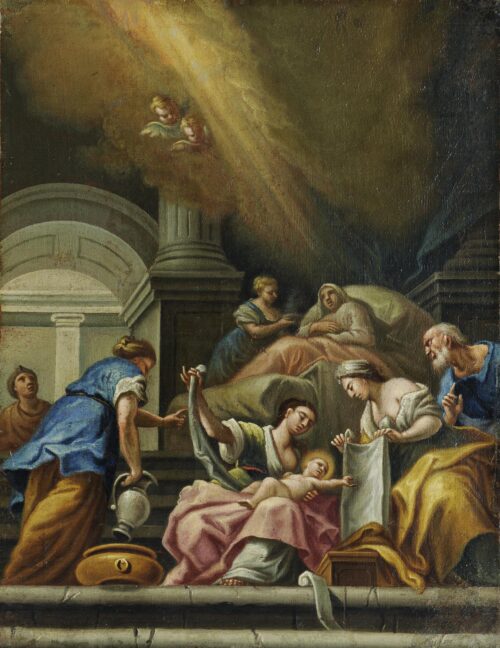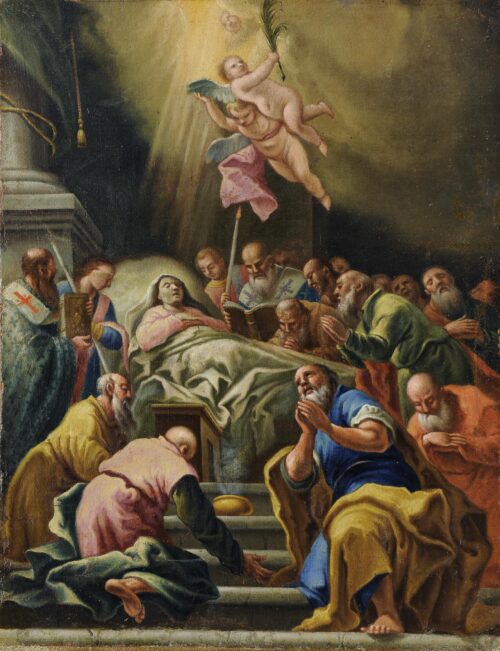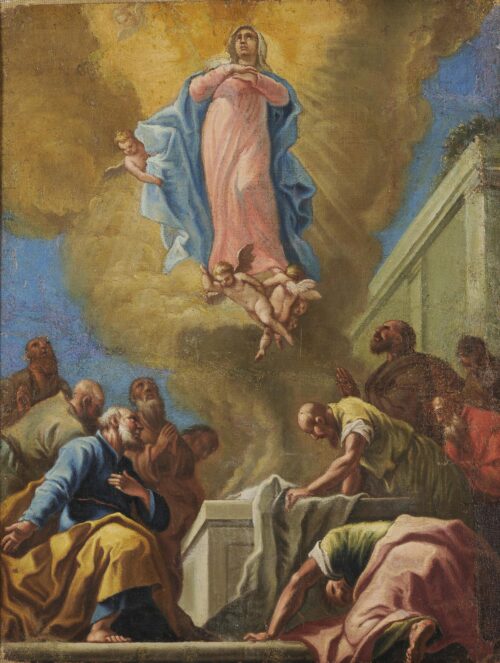
Doxaras Nikolaos (1710 - 1775)
The Nativity of the Virgin Mary, ca 1753-1754
A painter of the Ionian Island School, and a son of the painter and art theoretician Panagiotis Doxaras. After 1715 he and his family settled in Zakynthos and then moved to Lefkada. In 1722 he went to Corfu where in 1729 he enlisted in the army of the Count M. von Schulenburg, while after the death of his father he went to Venice to study military engineering and painting. It is probable he was influenced by Giambattista Piazetta or Giovanni-Batista Tiepolo, who dominated the artistic life of the city of that period, but it is not known where he studied or with whom. He returned to Greece in 1738 and for a few years settled in Lefkada, while in 1745 he was made an officer in the state police on Corfu. He also served in Cephalonia and in 1752 settled once and for all on Zakynthos, where he remained till his death.
His most important works were the decoration of the urania (ceiling) of the church of Faneromeni in Zakynthos (1754-1762/1765) and Ayios Minas on Lefkada (1762), which were done according to western models. The urania of Ayios Minas was destroyed by fire in 1976 but was recently repainted with he help of surviving black-and-white photographs. The decoration of Faneromeni is of particular interest because instead of containing the usual representation of the Pantocrator, the Nativity, Dormition and Translation of the Virgin Mary are depicted, done in accordance with the models employed by Roman Catholic churches of the time. These representations, except for the Nativity, were destroyed by the earthquake of 1953, as were a number of prophets on the walls, which, however, it seems likely, were done by Stephanos Pasigetis, at least in their final form. Preliminary drawings for the representations are to be found at the National Gallery, while the surviving “Nativity of the Virgin Mary” is at the Zakynthos Museum.

The Nativity of the Virgin Mary, ca 1753-1754

The Dormition of the Virgin Mary, ca 1753-1754

The Assumption of the Virgin

We use cookies to make our site work properly, to personalize content and ads, to provide social media features and to analyze our traffic. We also share information about how you use our site with our social media, advertising and analytics partners. Read the Cookies Policy.
These cookies are necessary for the website to function and cannot be switched off in our systems. They are usually only set in response to actions made by you which amount to a request for services, such as setting your privacy preferences, logging in or filling in forms. You can set your browser to block or alert you about these cookies, but some parts of the site will not then work. These cookies do not store any personally identifiable information.
If you disable this cookie, we will not be able to save your preferences. This means that every time you visit this website you will need to enable or disable cookies again.
These cookies tell us about how you use the site and they help us to make it better. For example these cookies count the number of visitors to our website and see how visitors move around when they are using it. This helps us to improve the way our site works, for example, by ensuring that users find what they are looking for easily. Our website uses Google Analytics for statistics reporting.
Please enable Strictly Necessary Cookies first so that we can save your preferences!